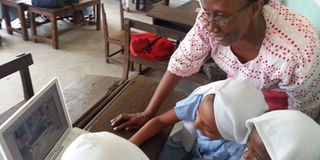Magic touch in class with ‘Abracadabra’ cartoon software

PHOTO | REBECCA OKWANY Ms Kiio with some of her pupils. Learning has become fun with cartoon app.
What you need to know:
- Both Mapenzi and Nuru say learning has been fun and lessons exciting since their class teacher, Ms Kiio, incorporated a cartoon software known as Abracadabra in her lessons.
- Once logged in, learners click on a tab labelled “Kenyan feed”. It has vocabulary, reading, spelling, stories, writing, singing, among other sectors of learning.
Mapenzi Charo and her classmate, Nuru Famauathman, both in Class Three at Central Girls Primary school, are chatting excitedly when we walk into their classroom.
“They can’t wait for the lesson to begin,” their class teacher, Joyce Kiio, says in response to our puzzled looks at the excited pupils, huddled in groups of five. Each group has a laptop.
“I love Julie!” screams Mapenzi excitedly. “She has a cat and there is always an interesting story about her and the cat.”
Both Mapenzi and Nuru say learning has been fun and lessons exciting since their class teacher, Ms Kiio, incorporated a cartoon software known as Abracadabra in her lessons.
They are not the only ones. The computer application is also in use in Makande, Ganjoni, Star of the Sea, and Aga Khan primary schools.
The use of the software is a joint initiative of the Aga Khan Development Network and Concordia University in Montreal, Canada. It aids students in numeracy, reading, and comprehension skills.
Interested teachers from local public schools were put through a training programme at Aga Khan Academy last year. Ms Kiio was one such teacher.
The software is believed to boost a pupil’s understanding of topics much faster by using cartoons and sound features that captivate the young learners.
Unlike regular classrooms, where students follow lessons on the blackboard under the guidance of the teacher, with Abracadabra, the teacher spends only a few minutes to introduce the topic, then leaves the rest of the learning time to the software.
Once logged in, learners click on a tab labelled “Kenyan feed”. It has vocabulary, reading, spelling, stories, writing, singing, among other sectors of learning.
Ms Kiio teaches English and science. Her pupils, she says, have recorded tremendous improvement in their performance owing to the attention that the computer teaching tool commands.
She explains that the video clips and the animated demonstrations assist teachers to communicate topics to students in a fun and simple form.
“The aim of this tool is to improve the standard of English. It brings ICT into normal curriculum and helps in learning,” says Ms Kiio.
Besides learning, she adds, printable resources and suggested lesson plans for teachers are also contained in the application.
“Abracadabra especially teaches pupils to read and understand English, which is important in their overall performance in school and their career later in life,” says Ms Kiio. “It also applies to other subjects. Children can tell the physical features, the weather, animals, plants, and other science matter from the film science lessons.”
Abracadabra comes with a feature for assessing and grading students’ performance in class through tests. The details are recorded as students’ reports.
However, Ms Kiio cautions that students need to broadly explore the features of the programme in order to better understand various subjects.
Professor of education technology at Concordia University and partner at AKDN, Philip Abrami, says the highly interactive and colourful feature of the tool engages learners in useful ways.
“Failure is going to be past tense for us,” declares the headteacher at Central Primary School. “A whole class can now read, understand, spell, and write coherently after going through the programme.”





